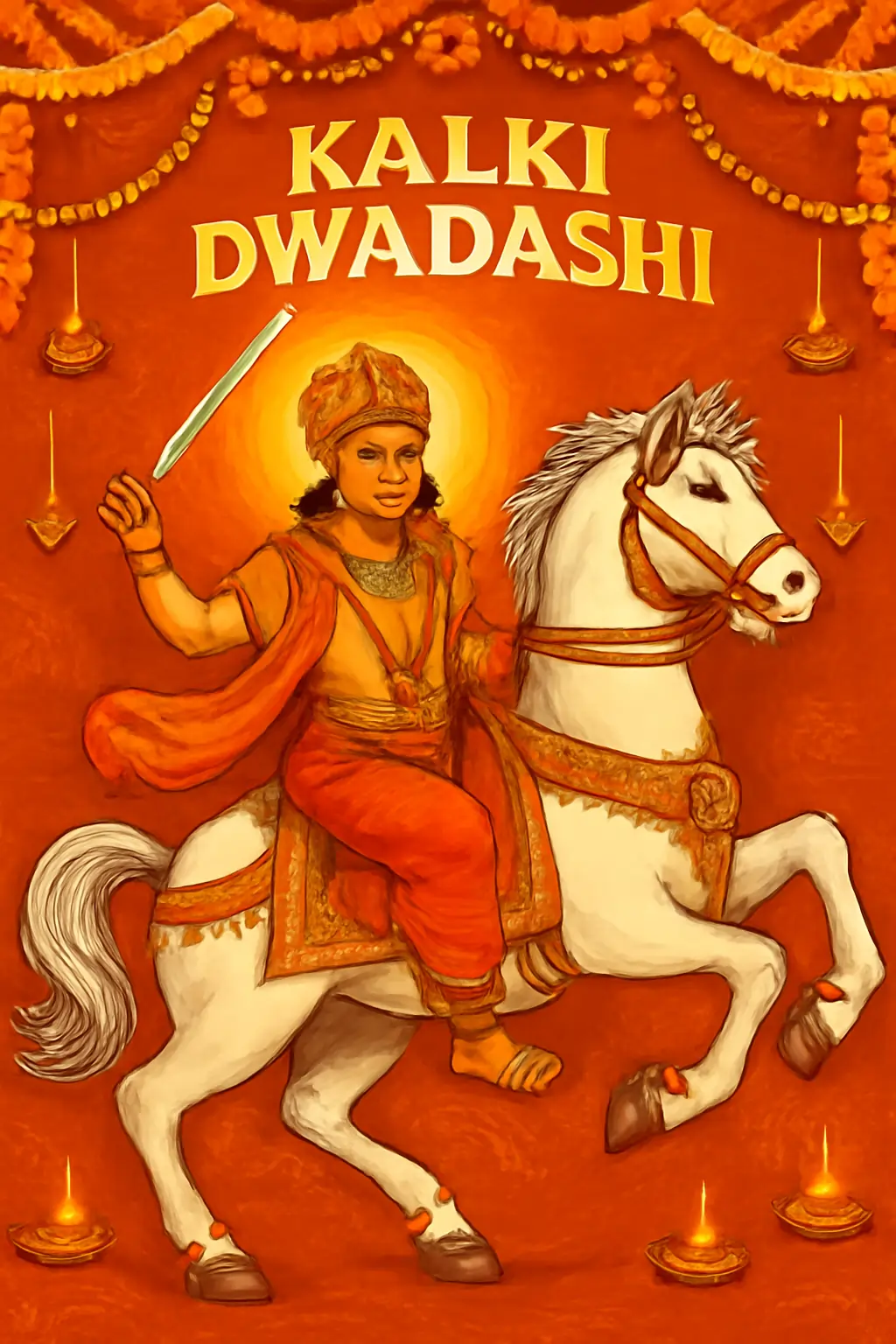Date: Wednesday, September 3, 2025
Tithi: Bhadrapada Shukla Dwadashi
Main Deity: Lord Kalki – the prophesied tenth avatar of Vishnu
Introduction
Kalki Dwadashi is a Vaishnava festival dedicated to Lord Kalki, the yet-to-appear tenth and final avatar of Lord Vishnu. Devotees observe it on the twelfth lunar day (Dwadashi) of the bright fortnight (Shukla Paksha) in the month of Bhadrapada.
In 2025, Kalki Dwadashi falls on September 3. On this day, devotees engage in fasting, special prayers, and temple rituals. Moreover, the occasion reminds people of the eventual triumph of dharma (righteousness) over adharma (chaos) in the age of Kali Yuga.
Also read about Spiritual Meaning of Kalki Dwadashi in Vaishnava Tradition
Significance of Kalki Dwadashi
From the Vaishnava perspective, Kalki is the harbinger of a new age (Satya Yuga). He will destroy evil forces and restore cosmic balance.
The name “Kalki” translates to destroyer of darkness or impurity. It symbolizes the removal of negativity and ignorance.
Scriptural references in the Bhagavata Purana, Vishnu Purana, and Kalki Purana describe Kalki’s birth in Shambhala village as the son of Vishnuyasha. Riding the white horse Devadatta and wielding a blazing sword, Kalki will end Kali Yuga.
In modern times, this prophecy inspires devotees to uphold righteousness now, preparing spiritually for the new era. Therefore, the festival is not only about awaiting Kalki’s arrival but also about living ethically in the present.
Rituals and Observances
1. Fasting (Upavasa)
Devotees fast either strictly or partially, breaking it after the evening puja or when the tithi ends. They usually consume satvik food such as fruits, milk, and simple meals. This discipline purifies the body and mind.
2. Kalki Puja
Worshippers perform puja for Vishnu or Kalki idols, and in some cases, Shaligram stones. They offer tulsi leaves, flowers, incense, and sweets. In addition, many chant Vishnu Sahasranama or Kalki mantras (Om Kalkiaya Namaha).
3. Scripture Reading & Kirtan
Devotees read from the Kalki Purana, Bhagavata Purana (Canto 12), or Vishnu Purana. Moreover, they sing bhajans such as the Dasavatara Stotra. These activities help immerse the community in devotion.
4. Temple Rituals
In temples, priests perform early morning abhisheka with water, milk, and sandalwood. They follow it with special aarti and distribute prasad. Some temples also display a decorated horse or Kalki idol during the puja to symbolize his future arrival.
Regional Celebrations Across India
North India
Here, people often call it Kalki Jayanti. Temples in Rajasthan and Uttar Pradesh hold satsangs and pujas. In Jaipur, the Govind Dev Ji Temple and other Vishnu temples attract large gatherings.
South India
In several Vaishnava temples, Kalki’s symbolism appears in horse processions (Ashwa Vahana). Many families observe the day quietly with home pujas in Tamil Nadu, Karnataka, and Andhra Pradesh.
East India
In Odisha and Bengal, Gaudiya Vaishnavas arrange bhajans and discourses. The Dasavatara Stotra is often recited, adding a musical touch to the celebrations.
West India
In Maharashtra and Gujarat, devotees perform puja at home and share Kalki stories in community gatherings. This keeps the tradition alive across generations.
History and Evolution of Kalki Dwadashi
The idea of Kalki appears in ancient Puranas, especially the Vishnu Purana and Bhagavata Purana.
During the medieval Bhakti movement, Vaishnava saints began formally celebrating the appearance days (Jayantis) of all avatars, including Kalki. As a result, Kalki Dwadashi became part of the devotional calendar.
In modern times, temple almanacs, ISKCON calendars, and online satsangs have increased global awareness. Consequently, the festival is now recognized even beyond India.
Modern Relevance in Kali Yuga
Today, Kalki Dwadashi urges devotees to focus on self-purification and truthfulness. With online kirtans, YouTube discourses, and virtual pujas, even those far from temples can participate.
The festival also serves as a reminder that dharma will always prevail. Therefore, followers take it as both a call to faith and an invitation to act righteously in their personal lives.
Conclusion
Kalki Dwadashi 2025 is more than a commemoration of a future divine event. It is an active practice of devotion, discipline, and hope. Through fasting, worship, and reflection, devotees strengthen their commitment to a life aligned with dharma. Ultimately, this faith ensures that when Lord Kalki arrives, his followers will already be walking the path of truth.

1 Comment